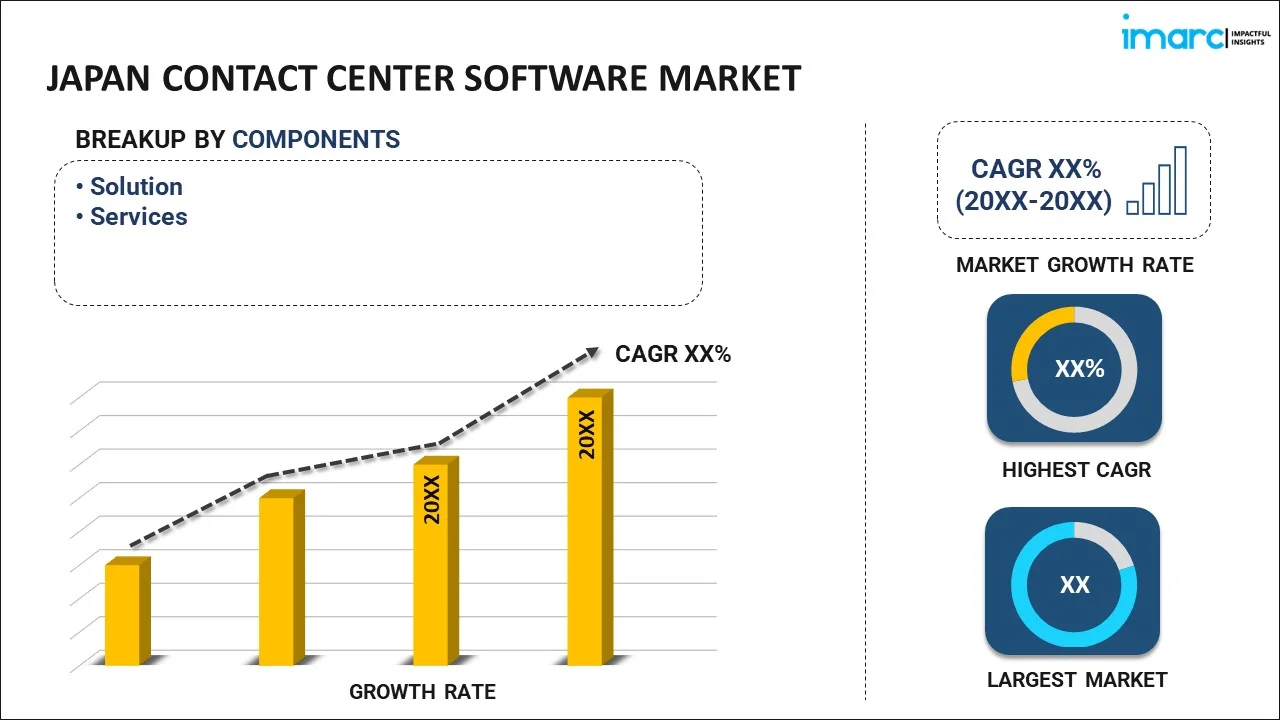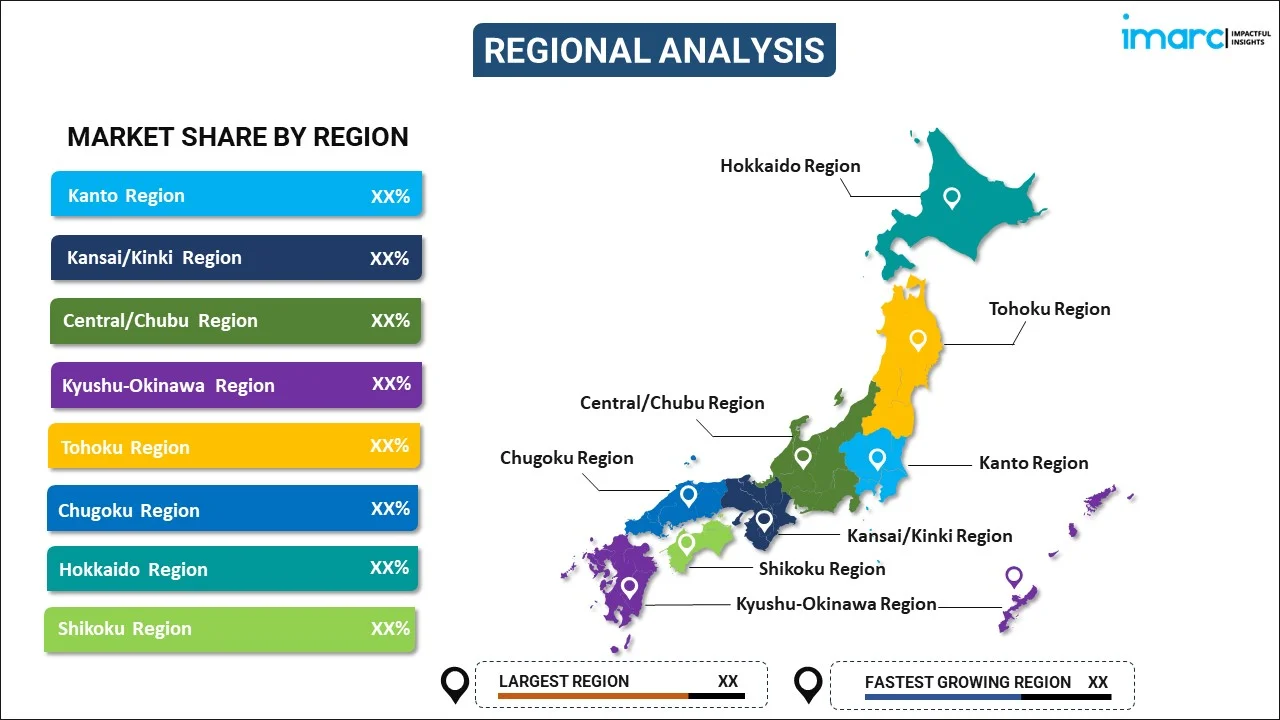
Japan Contact Center Software Market Report by Component (Solution, Services), Deployment Mode (On-premises, Cloud-based), Enterprise Size (Large Enterprises, Small and Medium-sized Enterprises), End Use (BFSI, Consumer Goods and Retail, Government, Healthcare, IT and Telecom, Travel and Hospitality, and Others), and Region 2025-2033
Market Overview:
Japan contact center software market size reached USD 1.9 Billion in 2024. Looking forward, IMARC Group expects the market to reach USD 8.5 Billion by 2033, exhibiting a growth rate (CAGR) of 16.6% during 2025-2033. The market is witnessing significant growth due to several key factors, including the increasing desire among consumers for seamless interactions with businesses, the widespread adoption of cloud-based solutions that provide improved flexibility, and the incorporation of advanced technologies aimed at enhancing the overall user experience.
|
Report Attribute
|
Key Statistics
|
|---|---|
|
Base Year
|
2024
|
|
Forecast Years
|
2025-2033
|
|
Historical Years
|
2019-2024
|
|
Market Size in 2024
|
USD 1.9 Billion |
|
Market Forecast in 2033
|
USD 8.5 Billion |
| Market Growth Rate 2025-2033 | 16.6% |
Contact center software is a technological solution created to optimize and elevate customer communication and support operations. It encompasses features like automated call routing, real-time monitoring, performance analytics, and customer relationship management (CRM) systems. This software functions as the central control center for overseeing both incoming and outgoing interactions across multiple communication channels, including telephone, email, chat, and social media. Its purpose is to enable businesses to effectively manage customer inquiries, address concerns, and offer personalized assistance. With its ability to enhance customer satisfaction, there is a growing demand for contact center software in Japan.
Japan Contact Center Software Market Trends:
In the context of the Japanese market, the current surge in the adoption of contact center software can be attributed to its flexibility, which enables organizations to easily scale their operations up or down as needed. This scalability is contributing significantly to market expansion. Furthermore, there is a growing demand for advanced solutions that effectively manage customer inquiries across various communication channels, including social media, chat, and email. This increased need is further driving the market's growth. Additionally, the rising adoption of contact center software is driven by its capacity to enhance agent productivity while reducing the necessity for physical infrastructure, thus bolstering market growth. Moreover, the heightened concern about data privacy and security among individuals in Japan is creating attractive growth prospects for investors within the industry. Furthermore, the market is benefiting from the growing necessity for solutions that enable companies to optimize their customer service operations and minimize response times. This need is actively supporting the overall expansion of the market. Similarly, organizations are increasingly seeking cloud-based contact center solutions that empower their agents to operate from remote locations. In addition to this, cloud-based solutions provide the required flexibility to sustain operations even during interruptions and guarantee seamless business continuity. This trend is expected to drive the market's expansion over the forecasted period.
Japan Contact Center Software Market Segmentation:
IMARC Group provides an analysis of the key trends in each segment of the market, along with forecasts at the country level for 2025-2033. Our report has categorized the market based on component, deployment mode, enterprise size, and end use.
Component Insights:

- Solution
- Automatic Call Distribution (ACD)
- Call Recording
- Computer Telephony Integration (CTI)
- Customer Collaboration
- Dialer
- Interactive Voice Responses (IVR)
- Others
- Services
- Integration and Deployment
- Support and Maintenance
- Training and Consulting
- Managed Services
The report has provided a detailed breakup and analysis of the market based on the component. This includes solution (automatic call distribution (ACD), call recording, computer telephony integration (CTI), customer collaboration, dialer, interactive voice responses (IVR), and others) and services (integration and deployment, support and maintenance, training and consulting, and managed services).
Deployment Mode Insights:
- On-premises
- Cloud-based
A detailed breakup and analysis of the market based on the deployment mode have also been provided in the report. This includes on-premises and cloud-based.
Enterprise Size Insights:
- Large Enterprises
- Small and Medium-sized Enterprises
The report has provided a detailed breakup and analysis of the market based on the enterprise size. This includes large enterprises and small and medium-sized enterprises.
End Use Insights:
- BFSI
- Consumer Goods and Retail
- Government
- Healthcare
- IT and Telecom
- Travel and Hospitality
- Others
A detailed breakup and analysis of the market based on the end use have also been provided in the report. This includes BFSI, consumer goods and retail, government, healthcare, IT and telecom, travel and hospitality, and others.
Regional Insights:

- Kanto Region
- Kansai/Kinki Region
- Central/ Chubu Region
- Kyushu-Okinawa Region
- Tohoku Region
- Chugoku Region
- Hokkaido Region
- Shikoku Region
The report has also provided a comprehensive analysis of all the major regional markets, which include Kanto Region, Kansai/Kinki Region, Central/ Chubu Region, Kyushu-Okinawa Region, Tohoku Region, Chugoku Region, Hokkaido Region, and Shikoku Region.
Competitive Landscape:
The market research report has also provided a comprehensive analysis of the competitive landscape. Competitive analysis such as market structure, key player positioning, top winning strategies, competitive dashboard, and company evaluation quadrant has been covered in the report. Also, detailed profiles of all major companies have been provided.
Japan Contact Center Software Market Report Coverage:
| Report Features | Details |
|---|---|
| Base Year of the Analysis | 2024 |
| Historical Period | 2019-2024 |
| Forecast Period | 2025-2033 |
| Units | Billion USD |
| Scope of the Report | Exploration of Historical Trends and Market Outlook, Industry Catalysts and Challenges, Segment-Wise Historical and Future Market Assessment:
|
| Components Covered |
|
| Deployment Modes Covered | On-premises, Cloud-based |
| Enterprise Sizes Covered | Large Enterprises, Small and Medium-sized Enterprises |
| End Uses Covered | BFSI, Consumer Goods and Retail, Government, Healthcare, IT and Telecom, Travel and Hospitality, Others |
| Regions Covered | Kanto Region, Kansai/Kinki Region, Central/ Chubu Region, Kyushu-Okinawa Region, Tohoku Region, Chugoku Region, Hokkaido Region, Shikoku Region |
| Customization Scope | 10% Free Customization |
| Post-Sale Analyst Support | 10-12 Weeks |
| Delivery Format | PDF and Excel through Email (We can also provide the editable version of the report in PPT/Word format on special request) |
Key Questions Answered in This Report:
- How has the Japan contact center software market performed so far and how will it perform in the coming years?
- What has been the impact of COVID-19 on the Japan contact center software market?
- What is the breakup of the Japan contact center software market on the basis of component?
- What is the breakup of the Japan contact center software market on the basis of deployment mode?
- What is the breakup of the Japan contact center software market on the basis of enterprise size?
- What is the breakup of the Japan contact center software market on the basis of end use?
- What are the various stages in the value chain of the Japan contact center software market?
- What are the key driving factors and challenges in the Japan contact center software?
- What is the structure of the Japan contact center software market and who are the key players?
- What is the degree of competition in the Japan contact center software market?
Key Benefits for Stakeholders:
- IMARC’s industry report offers a comprehensive quantitative analysis of various market segments, historical and current market trends, market forecasts, and dynamics of the Japan contact center software market from 2019-2033.
- The research report provides the latest information on the market drivers, challenges, and opportunities in the Japan contact center software market.
- Porter's five forces analysis assist stakeholders in assessing the impact of new entrants, competitive rivalry, supplier power, buyer power, and the threat of substitution. It helps stakeholders to analyze the level of competition within the Japan contact center software industry and its attractiveness.
- Competitive landscape allows stakeholders to understand their competitive environment and provides an insight into the current positions of key players in the market.
Need more help?
- Speak to our experienced analysts for insights on the current market scenarios.
- Include additional segments and countries to customize the report as per your requirement.
- Gain an unparalleled competitive advantage in your domain by understanding how to utilize the report and positively impacting your operations and revenue.
- For further assistance, please connect with our analysts.
 Inquire Before Buying
Inquire Before Buying
 Speak to an Analyst
Speak to an Analyst
 Request Brochure
Request Brochure
 Request Customization
Request Customization




.webp)




.webp)












